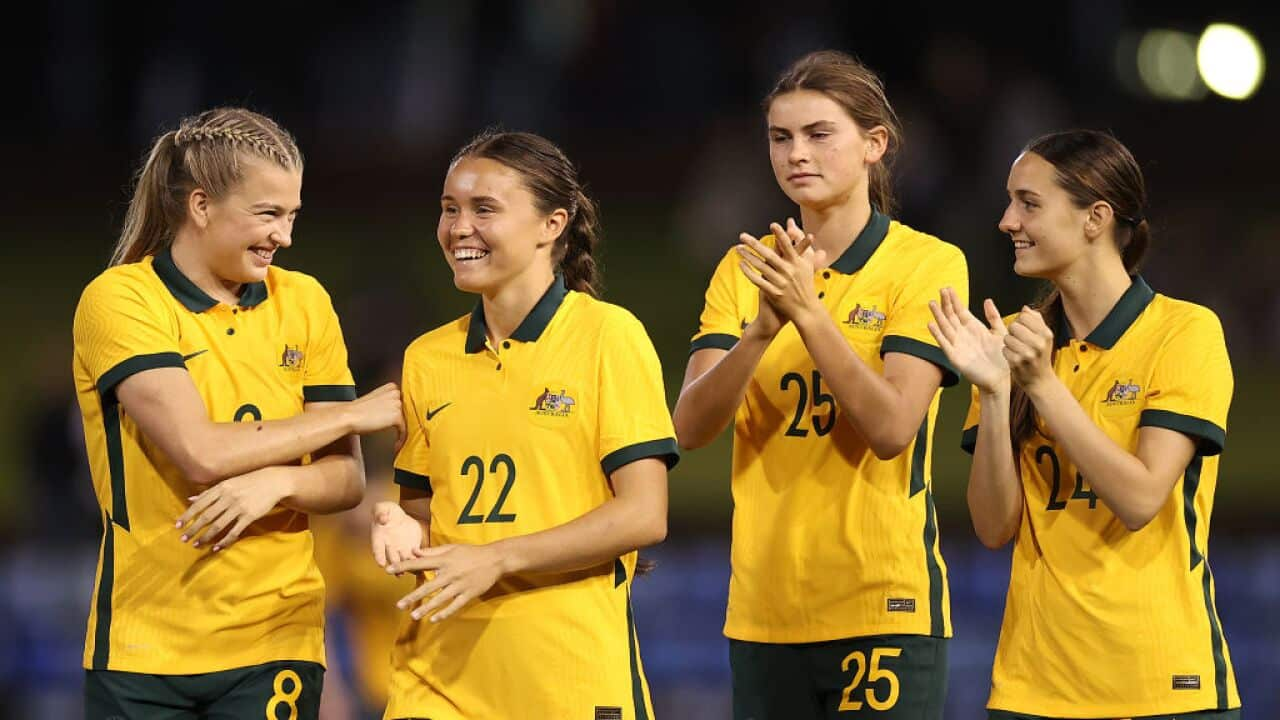As joint hosts with New Zealand, Australia have a once in a lifetime opportunity to not only win the world cup on home soil, but to firmly establish women’s football here for decades to come.
England’s recent Euro 2022 victory has shown how inspiring hosting, and winning, a large tournament can be.
Over 87,000 fans attended the Euro 2022 women’s final at Wembley. That figure was a record for any European Championship final – men’s or women’s.
England now plan to capitalise on their victory and push women’s football like never before, and so do Australia. Work is well underway here to use the tournament as a gigantic stimulus to Australian football.
Football Australia has already secured $230 million in federal and state funding, as part of the ‘Legacy 23’ plan. The program aims to deliver “positive and enduring benefits” beyond 2023. It has a five-pillars strategy, where participation, community facilities, leadership and development, tourism, and high performance are all fundamental.
A FIFA tournament is a big deal. It’s a global ‘mega event.’ The 2015 Women’s World Cup in Canada had over 1.3 million fans through the turnstiles. The 2023 tournament will be the biggest sporting event here since Sydney 2000.
A lasting legacy for grassroots football, both male and female, is on offer. Capitalise on the World Cup and take the game to new heights here. The aim is to raise the profile of the sport, build new facilities, train new coaches and referees, and get girls across Australia playing football in schools.
In England, the plan is for 75% of schools to provide access to girls’ football and 75% of grassroots clubs to have at least one girls’ team, allowing for a healthier and happier female population.
Why shouldn’t every school in Australia strive towards offering all their students the opportunity to play football? If sports like Aussie Rules, basketball and cricket are available, so should football. Whoever wants to play, should get the chance to play.
According to Football Australia’s 2021 National Participation Report, only 13% of registered referees are female. So, clearly, work needs to be done regarding recruiting, training, and keeping hold of new female referees. If anyone wants to become a referee, let’s help make it happen.
Professional, televised sport is often what attracts youngsters. They watch their heroes and then want to emulate them.
After years in the wilderness, the English FA spent a decade turning the Women’s Super League into one of the best women’s football leagues in the world. It became professional in 2018, and games are now shown on both free-to-air television and Sky TV.
Australia is also making great progress in increasing female participation in football and expanding and further establishing the A-League Women.
Despite COVID-19, 2021 saw a 21% growth, since 2020, in women's outdoor football in Australia. Our female footballers need to play more, and the opportunities for women to play in big games are steadily increasing. Annual trans-Tasman international games are being discussed, and there are proposals for a women’s domestic cup competition to be introduced.
Since its creation in 2008, the A-League Women, formerly known as the W-League, has expanded from eight to 11 teams for next season. The men’s, women's, and youth leagues have been brought together under a unified A-Leagues banner. Wellington Phoenix joining the A-League Women and becoming New Zealand’s first professional women’s football team is one early sign of the tournament’s legacy.
Broadcast rights for the A-League Women have been passed around between Fox Sports, the ABC, and now Network Ten. They currently show one A-League Men, and one A-League Women match on terrestrial TV each week. And it’s terrestrial television that’s the key to nationwide exposure. Fans in Australia are now able to watch quality women’s football.
The Euro 2022 final drew a huge TV audience. With over 17 million viewers, it was the most-watched women’s football game on British television of all-time. It was also the most-watched programme on British television in 2022 so far.
Although the A-League Women is steadily improving, currently, virtually every senior Matildas player plays their club football overseas. Australia’s Sam Kerr reportedly earns around A$600,000 a season playing for Chelsea.
However, the average English Women’s Super League salary is said to be around a tenth of what the big stars earn.
Professional women footballers often face poorer facilities, lower pay, shorter contracts and less opportunities to become full-time professionals than men.
Women were effectively banned from playing the game by the English Football Association for a large part of the last century. After gaining popularity in the early 1900s, the women’s game only began to return in the 1970s. So there’s a lot of catching up to do. But it is happening. England Women’s next game at Wembley, against the USA in October, saw an unprecedented demand for tickets and is now sold out.
Earlier this year, the United States national women’s team won a US$24 million pay-out, and a commitment from US Soccer to have equal pay for the men’s and women’s national teams in all competitions. This landmark settlement ended a titanic legal battle and it was a game-changer for female sports teams.
Although a number of countries, including Australia, have introduced, or are working towards introducing equal pay for their men’s and women’s senior teams, the U.S. have gone even further and agreed to an equal share of tournament prize money.
Pay and opportunities can always be improved, and a level financial playing field will help attract young women towards a career playing professional football.
According to Football Australia, women currently make up 22% of Australia’s participation base. Football Australia’s Gender Equality Action Plan aims to have 50% gender participation by 2027.
In the AFL, women and girls make up over 30% of players. According to the AFL’s website, all states and territories have recorded recent growth in female participation. So football faces stiff competition. But women and girls' participation in football is also growing year-on-year, so it can be done. There is no reason why football can’t challenge Aussie Rules, cricket and rugby for a place at the top of Australian sport.
It’s also about increasing diversity within the game. Multicultural participation and disability participation. More needs to be done to include marginalised groups.
The indigenous names of the host towns and cities will be used alongside their English names at the 2023 Australia and New Zealand event. This is a fantastic opportunity to use the power of sport to create a fairer, more inclusive, healthier society. The 2023 tournament can change lives.
Strengthening the A-League Women and increasing its crowds is vital. And so is getting schools and community clubs to nurture youngsters interested in football. Because, if the framework isn’t developed and maintained at grassroots level, local girls will struggle to make it all the way to the A League and the Matildas.
A number of Olympic Games were awarded to countries who promised to deliver a lasting legacy but then failed to deliver. Australia is determined and well prepared to avoid that kind of wasted legacy.
In the Matildas, we have a much-loved, successful, marketable team who will inspire youngsters across the nation. But, as well as energising the girls who already love the game, let’s reach out to those who are yet to discover it.
Matilda’s star Caitlin Foord told the ABC: “I think it will do massive things for the game in Australia for both girls and boys growing up playing football. It gives younger generations and upcoming footballers a chance to see what they can strive to be and drive towards.”
With an expanding A-League Women and steady growth in female participation, the legacy is already unfolding. Women’s football has had to fight long and hard for its survival, but now there’s a genuine atmosphere of love and appreciation for the women’s game.
In November last year, over 36,000 fans watched the Matildas play the United States in Sydney. It was a record attendance for a Matildas' home game.
These are exciting times for Australian football. Australians love sport and they love getting behind a national team. The 2023 Women’s World Cup will undoubtedly be a success and draw huge crowds. Most stadia will be sold out or close to capacity. The interest is there – the product is undeniably good.
The challenge will then be to maintain the momentum. To remove the participation barriers, keep improving facilities, hold onto those fans, keep the advertising and TV revenues high, and for football to cement itself as a dominant code in Australia.














